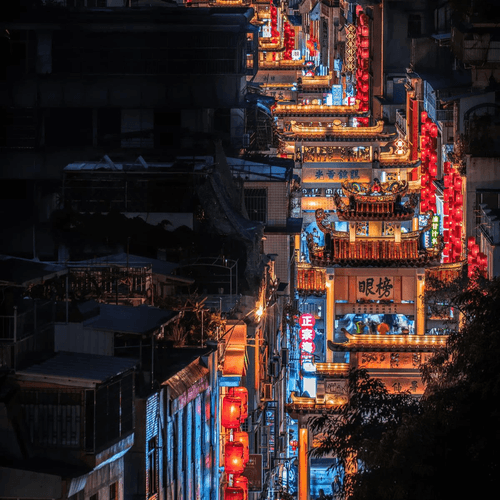
Walk Through Time: Paifang Street– The Living Museum of Chaozhou
Hello, fellow travelers! Are you ready for an unforgettable journey into the heart of authentic Chinese history and culture? Forget the towering skylines and flashing lights for a moment. Today, I want to take you to a place where time slows down, where every stone whispers an ancient tale, and where the air is thick with the scent of history and freshly brewed tea.
Welcome to Chaozhou's Paifang Street (牌坊街), the soul of an over 1,600-year-old city in the eastern part of Guangdong Province, China.
At TourPal.com, we believe in genuine travel experiences, and this historical street is the perfect embodiment of that. It's not just a street; it's a monumental outdoor museum, a living scroll that documents the triumphs, virtues, and artistic genius of the people of Chaozhou throughout the Ming and Qing Dynasties (14th to 20th centuries).
I. History & The Stone Forest of Honor: What Exactly is a "Paifang"?
(一、历史与荣耀的石林:“牌坊”究竟是什么?)
Imagine a trophy case, but instead of glass and wood, it's crafted from massive, intricately carved granite, standing proudly in the middle of a main road. That, in essence, is a Paifang (牌坊)—a traditional Chinese architectural archway.
Question: What is a Paifang, and why are there so many here?
In ancient China, the central government would erect these magnificent arches to honor people who achieved great success in imperial examinations (becoming high officials or scholars), exhibited exceptional filial piety (respect for parents and elders), or demonstrated unwavering loyalty and chastity. It was the highest form of official recognition—a permanent, public badge of honor for both the individual and their entire family lineage.
The street we walk on today, officially named Taiping Road (太平路), is famous for its dense cluster of these historical markers. Originally, there were over 150 paifangs scattered throughout the old city and its surrounding villages. After many years of restoration, 23 stone paifangs now stand tall along this main artery, forming the largest, most concentrated group of ancient archways in all of China. This is why it earned the nickname “Paifang Street”—a true “Stone Forest of Honor.”
As the old local saying goes, "The abundance of Paifangs reflects the beauty of the morality." Chaozhou, historically known as a place of profound scholarly tradition, produced an extraordinary number of talented individuals. Walking here is like flipping through a historical "Who's Who" of the region, where every single archway—like the one dedicated to the only Chaozhou-born Zhuangyuan (top scholar in the highest imperial exam)—tells a deep, personal story of struggle, dedication, and ultimate triumph.
II. Art & Architecture: A Fusion of Stone and Wisdom
(二、艺术与建筑:石头与智慧的融合)
Beyond their historical significance, the Paifangs are masterpieces of Ming and Qing Dynasty stone carving. They are primarily constructed from granite, a hard stone that has allowed them to withstand centuries of weathering.
A Closer Look at the Craftsmanship:
Materials and Structure: Most Paifangs here are of the "Four-Pillared, Three-Gate, Three-Storied" style. Look closely at the robust stone pillars, the multi-layered roofs, and the detailed decorative carvings that adorn every surface.
The Art of Stone Carving: This is where Chaozhou's legendary craftsmanship shines. The granite surfaces are not merely smoothed; they are brought to life with relief carvings depicting:
Dragons and Phoenixes: Symbols of imperial power and auspiciousness.
Mythical Creatures and Auspicious Patterns: Representing good fortune, longevity, and prosperity.
Historical Figures and Scenes: Often relating directly to the story of the person being honored.
Notice how the carvings are often multi-layered, giving them a three-dimensional depth that is breathtaking.
Calligraphy: Each Paifang is crowned with exquisite calligraphy, often in large, bold characters, proclaiming the honorific title or the virtue being celebrated. These are often the work of famous calligraphers or even the Emperor himself—a true testament to the street's cultural value.
The Surrounding Landscape: A Chinese-Western Blend
The architecture surrounding the Paifangs is equally fascinating. As you stroll, look up! You'll notice a unique blend of traditional Chinese courtyard homes and the distinct, two- or three-story buildings known as Qilou (骑楼), or "Riding Buildings."
The Qilou Style: These are colonial-era structures with an open arcade or veranda on the ground floor, extending over the sidewalk. This design, influenced by the architecture of Southeast Asia, was ingeniously adapted by Chaozhou merchants who traveled and traded abroad. It provides a sheltered walkway, perfect for escaping the summer sun or a sudden downpour—a practical and elegant example of a fusion of Chinese tradition and Western influence.
III. Culture & Intangible Heritage: The Soul of Chaozhou
(三、文化与非遗:潮州之魂)
Paifang Street is not a dusty monument; it’s a living classroom for Intangible Cultural Heritage (非物质文化遗产, Fei Wu Zhi Wen Hua Yi Chan). The street and the narrow lanes that branch off it (like the famous Jiadi Lane, 甲第巷) are filled with workshops and teahouses that keep ancient traditions alive.
The Ritual of Chaozhou Kung Fu Tea (潮州工夫茶):
Question: What is special about Chaozhou Kung Fu Tea?
This is more than just drinking tea; it is a meticulous, ritualistic art form that is central to Chaozhou social life. The word “Kung Fu” here doesn't mean martial arts, but rather "skill" or "effort". The process involves specific small teapots and cups, precise water temperature, rapid steeping, and a dedicated spirit.
Experience it: Stop at one of the many traditional teahouses. Watch the tea master perform the ceremony, and savor the complex, subtle flavors of the local Phoenix Dancong Oolong Tea (凤凰单丛茶). It’s an exercise in patience and appreciation—the perfect way to slow down and connect with the local pace of life.
The Craftsmanship of Chaozhou:
Many small shops along the street are the homes and studios of master artisans:
Chaozhou Wood Carving (潮州木雕): Known for its intricate, multi-layered carvings, often gilded with gold leaf, making it look incredibly rich and detailed—it's like a tapestry woven from wood.
Chaozhou Embroidery (潮绣): Famous for its delicate stitches, vibrant colors, and three-dimensional effects, often incorporating gold and silver threads.
Hand-Pulled Clay Teapots (手拉壶): The specialized small clay teapots used for Kung Fu Tea are still handmade by artisans on the street, using ancient, precise techniques.
Folk Arts and Customs:
Keep an eye out for performances of Chaozhou Opera (潮剧) or the fascinating Iron Wire Puppet Show (铁枝木偶戏), often performed in the evening or on weekends. These lively spectacles showcase the local dialect, music, and colorful costumes, offering a deeper dive into the region's unique cultural identity.
IV. Scenery & Key Landmarks: From the Archways to the River
(四、景观与主要地标:从牌坊到江河)
Paifang Street acts as the central axis of the entire ancient city, leading directly to the most iconic landmarks.
Guangji Gate Tower (广济门城楼):
The magnificent eastern gate of the old city, built in the Ming Dynasty. It is a stunning, multi-tiered structure that marks the eastern end of Paifang Street and serves as the perfect starting point for your visit. Climb up the tower for a sweeping view of the street stretching into the distance and the mighty Han River flowing beyond.
Guangji Bridge (广济桥):
Question: What's so special about the Guangji Bridge?
Right outside the Guangji Gate, spanning the Han River, stands the world-famous Guangji Bridge, also known as Xiangzi Bridge (湘子桥). It is one of China’s "Four Famous Ancient Bridges" and a true marvel of engineering.
The Unique Feature: It is famous for its unique construction: "Eighteen Shuttle Boats and Twenty-Four Pavilions" (十八梭船廿四洲). The bridge is composed of two long stone arch sections, one from the east bank and one from the west bank. Crucially, the middle section is a floating pontoon bridge made of eighteen connected wooden boats!
The Transformation: Every evening, the boats are moved to allow river traffic to pass—a stunning daily spectacle! The bridge is truly "open and closed," functioning both as a bridge and a lock. At night, the bridge lights up, often accompanied by a mesmerizing light and music show, transforming it into a glowing dragon over the water.
Kaiyuan Temple (开元寺):
Just a short walk from the Paifang Street, this ancient Buddhist temple, dating back to the Tang Dynasty, is one of the most important centers of Buddhism in eastern Guangdong. Its serene atmosphere, intricate architectural details, and vibrant religious life offer a peaceful contrast to the bustling street.
V. Culinary Journey: Taste the Flavor of Chaozhou
(五、美食之旅:品味潮州的味道)
No trip to Paifang Street is complete without indulging in the local gastronomy. Chaozhou cuisine (潮州菜, Cháozhōu cài), also known as Teochew cuisine, is renowned across the globe for its freshness, meticulous preparation, and light, delicate flavors.
The street itself is a paradise for street food lovers and a feast for the eyes.
Must-Try Local Delicacies:
Beef Hot Pot (牛肉火锅): Forget what you know about hot pot! Chaozhou beef hot pot focuses on using incredibly fresh, hand-sliced beef, with every part of the cow named and cooked for an exact number of seconds. The hand-beaten beef balls are renowned worldwide for their incredible bounce and texture.
Chaozhou Kway Teow (粿条): A flat rice noodle dish, often served in a savory soup with premium beef or seafood. Simple, yet deeply satisfying.
Sweet Snacks (Guo, 粿): Look for various steamed or pan-fried dumplings and cakes called Guo. Try Fen Guo (粉粿), filled with savory fillings, or the sweet Taosu Bing (朥糕), a rich, flaky pastry.
Gan Cao Fruit (甘草水果): A refreshing, unique snack where fresh seasonal fruits (like plums, mangoes, or guavas) are sliced and mixed with a sweet and sour sauce made from licorice root and preserved plum. It’s the perfect palate cleanser!
Local Treats & Souvenirs: Don't leave without trying the "Three Treasures of Chaozhou" (潮州三宝): Lao Yao Jie (老药桔) (preserved kumquats/citrus), Huang Pi Zhi (黄皮豉) (preserved wampee), and Fo Shou Lao Xiang Huang (佛手老香黄) (preserved Buddha's Hand citron). These are often enjoyed with tea and are fantastic souvenirs.
VI. Practical Guide: When to Go & How to Play
(六、游玩实用指南:何时何地?)
Best Time to Visit:
Weather: Spring (March to May) and Autumn (September to November) offer the most pleasant weather, avoiding the summer heat and humidity.
Time of Day: Paifang Street is fantastic both day and night!
Daytime: Best for appreciating the stone carving details, exploring the side lanes, and visiting the museums and workshops.
Nighttime: The street and the major landmarks like Guangji Gate and Guangji Bridge are beautifully lit up, offering a truly romantic and dramatic atmosphere. Don’t miss the Guangji Bridge light show (check local timings)!
Walking and Exploring:
The Main Path: Start at the Guangji Gate Tower and walk down the main Paifang Street (Taiping Road), stopping to read the plaques and admire the carvings.
Venture into the Alleys: The real charm of Chaozhou is found in the narrow lanes (巷, Xiàng) running perpendicular to Paifang Street, especially Jiadi Lane. These lanes are filled with well-preserved traditional courtyard houses, which often feature stunning examples of wood carving and stucco sculpture. It's an intimate look at the domestic life of historical Chaozhou.
Pace Yourself: The street is about 1.9 kilometers long. Take your time. Sit down for a cup of tea. Watch an artisan work. Let the ancient vibe wash over you.
Conclusion: Your Invitation to the Past
Paifang Street is a powerful experience. It’s a physical manifestation of a civilization that valued education, morality, and craftsmanship above all else. It is a place that invites you to not just observe history, but to participate in it—by sipping the tea, tasting the food, and walking the same stone paths as generations of scholars and honored citizens before you.
Come, step into the stone forest of Paifang Street. Let us at www.tourpal.com help you uncover the magic of Chaozhou, a city that truly lives up to its ancient title: “The Famous State of the Southern Territory.” Your journey through time begins here!


